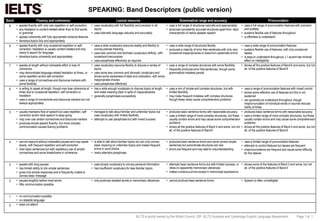The document provides descriptors for 9 different bands (levels) that are used to evaluate abilities in speaking and writing in English based on IELTS exams. For each band, descriptors are given for areas like fluency, coherence, vocabulary, grammar, and pronunciation for speaking. For writing, descriptors cover areas like task response, coherence, vocabulary, and grammar. The bands range from non-verbal (Band 1) to native-speaker ability (Band 9).

